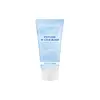What's inside
What's inside
 Key Ingredients
Key Ingredients

 Benefits
Benefits

 Concerns
Concerns

No concerns
 Ingredients Side-by-side
Ingredients Side-by-side

Water
Skin ConditioningButylene Glycol
HumectantCyclopentasiloxane
EmollientGlycerin
HumectantHelianthus Annuus Seed Oil
EmollientSodium Hyaluronate
HumectantPolyglutamic Acid
Skin ConditioningPhenyl Trimethicone
Skin ConditioningSqualane
EmollientOctyldodecanol
EmollientGlycereth-26
HumectantPentylene Glycol
Skin ConditioningHamamelis Virginiana Water
AstringentGlyceryl Stearate Citrate
EmollientPolyglyceryl-3 Distearate
EmulsifyingPolyglyceryl-10 Dilaurate
Dipotassium Glycyrrhizate
HumectantNicotinoyl Dipeptide-23
Skin ConditioningAcetyl Hexapeptide-8
Humectant1,2-Hexanediol
Skin ConditioningCarbomer
Emulsion StabilisingArginine
MaskingAllantoin
Skin ConditioningPanthenol
Skin ConditioningDimethicone Crosspolymer
Emulsion StabilisingSodium Polyacryloyldimethyl Taurate
Emulsion StabilisingCaprylyl Glycol
EmollientDicaprylyl Ether
EmollientAdenosine
Skin ConditioningPropanediol
SolventCaprylhydroxamic Acid
Water, Butylene Glycol, Cyclopentasiloxane, Glycerin, Helianthus Annuus Seed Oil, Sodium Hyaluronate, Polyglutamic Acid, Phenyl Trimethicone, Squalane, Octyldodecanol, Glycereth-26, Pentylene Glycol, Hamamelis Virginiana Water, Glyceryl Stearate Citrate, Polyglyceryl-3 Distearate, Polyglyceryl-10 Dilaurate, Dipotassium Glycyrrhizate, Nicotinoyl Dipeptide-23, Acetyl Hexapeptide-8, 1,2-Hexanediol, Carbomer, Arginine, Allantoin, Panthenol, Dimethicone Crosspolymer, Sodium Polyacryloyldimethyl Taurate, Caprylyl Glycol, Dicaprylyl Ether, Adenosine, Propanediol, Caprylhydroxamic Acid
Water
Skin ConditioningGlycerin
HumectantPropanediol
SolventPanthenol
Skin ConditioningPentaerythrityl Tetraethylhexanoate
EmollientHydrogenated Poly(C6-14 Olefin)
Emollient1,2-Hexanediol
Skin ConditioningPolymethylsilsesquioxane
Ammonium Acryloyldimethyltaurate/Vp Copolymer
Trehalose
HumectantGlyceryl Stearate Citrate
EmollientHydroxyethyl Acrylate/Sodium Acryloyldimethyl Taurate Copolymer
Emulsion StabilisingC14-22 Alcohols
Emulsion StabilisingArachidyl Alcohol
EmollientGlyceryl Stearate
EmollientGlyceryl Caprylate
EmollientBehenyl Alcohol
EmollientC12-20 Alkyl Glucoside
EmulsifyingEthylhexylglycerin
Skin ConditioningArachidyl Glucoside
EmulsifyingButylene Glycol
HumectantDisodium EDTA
Sorbitan Isostearate
EmulsifyingAllantoin
Skin ConditioningMadecassoside
AntioxidantScutellaria Baicalensis Root Extract
AstringentGlucose
HumectantCamellia Sinensis Leaf Extract
AntimicrobialTocopherol
AntioxidantWater, Glycerin, Propanediol, Panthenol, Pentaerythrityl Tetraethylhexanoate, Hydrogenated Poly(C6-14 Olefin), 1,2-Hexanediol, Polymethylsilsesquioxane, Ammonium Acryloyldimethyltaurate/Vp Copolymer, Trehalose, Glyceryl Stearate Citrate, Hydroxyethyl Acrylate/Sodium Acryloyldimethyl Taurate Copolymer, C14-22 Alcohols, Arachidyl Alcohol, Glyceryl Stearate, Glyceryl Caprylate, Behenyl Alcohol, C12-20 Alkyl Glucoside, Ethylhexylglycerin, Arachidyl Glucoside, Butylene Glycol, Disodium EDTA, Sorbitan Isostearate, Allantoin, Madecassoside, Scutellaria Baicalensis Root Extract, Glucose, Camellia Sinensis Leaf Extract, Tocopherol
 Reviews
Reviews

Ingredients Explained
These ingredients are found in both products.
Ingredients higher up in an ingredient list are typically present in a larger amount.
1,2-Hexanediol is a synthetic liquid and another multi-functional powerhouse.
It is a:
- Humectant, drawing moisture into the skin
- Emollient, helping to soften skin
- Solvent, dispersing and stabilizing formulas
- Preservative booster, enhancing the antimicrobial activity of other preservatives
Allantoin is a soothing ingredient known for its protective and moisturizingg properties. Because of this, it is often added to products with strong active ingredients.
Studies show higher concentrations of this ingredient can promote wound healing.
Though it can be derived from the comfrey plant, allantoin is produced synthetically for cosmetic products to ensure purity.
Learn more about AllantoinButylene Glycol (or BG) is used within cosmetic products for a few different reasons:
Overall, Butylene Glycol is a safe and well-rounded ingredient that works well with other ingredients.
Though this ingredient works well with most skin types, some people with sensitive skin may experience a reaction such as allergic rashes, closed comedones, or itchiness.
Learn more about Butylene GlycolGlycerin is already naturally found in your skin. It helps moisturize and protect your skin.
A study from 2016 found glycerin to be more effective as a humectant than AHAs and hyaluronic acid.
As a humectant, it helps the skin stay hydrated by pulling moisture to your skin. The low molecular weight of glycerin allows it to pull moisture into the deeper layers of your skin.
Hydrated skin improves your skin barrier; Your skin barrier helps protect against irritants and bacteria.
Glycerin has also been found to have antimicrobial and antiviral properties. Due to these properties, glycerin is often used in wound and burn treatments.
In cosmetics, glycerin is usually derived from plants such as soybean or palm. However, it can also be sourced from animals, such as tallow or animal fat.
This ingredient is organic, colorless, odorless, and non-toxic.
Glycerin is the name for this ingredient in American English. British English uses Glycerol/Glycerine.
Learn more about GlycerinGlyceryl Stearate Citrate is a citric acid ester of glyceryl stearate.
It is an emulsifier, emollient, and a surfactant.
Emulsifiers help stabilize a product. It does this by preventing certain ingredients from separating. Common ingredients include oils and water, which do not mix naturally. Emulsifiers have properties that help keep ingredients such as these together.
Emollients help soothe and soften the skin. They do this by creating a protective film on your skin. This barrier helps trap moisture and keeps your skin hydrated. Emollients may be effective at treating dry or itchy skin.
Surfactants help gather oils, dirt, and other pollutants from the skin. This helps them to be easily rinsed away.
Learn more about Glyceryl Stearate CitratePanthenol is a common ingredient that helps hydrate and soothe the skin. It is found naturally in our skin and hair.
There are two forms of panthenol: D and L.
D-panthenol is also known as dexpanthenol. Most cosmetics use dexpanthenol or a mixture of D and L-panthenol.
Panthenol is famous due to its ability to go deeper into the skin's layers. Using this ingredient has numerous pros (and no cons):
Like hyaluronic acid, panthenol is a humectant. Humectants are able to bind and hold large amounts of water to keep skin hydrated.
This ingredient works well for wound healing. It works by increasing tissue in the wound and helps close open wounds.
Once oxidized, panthenol converts to pantothenic acid. Panthothenic acid is found in all living cells.
This ingredient is also referred to as pro-vitamin B5.
Learn more about PanthenolPropanediol is an all-star ingredient. It softens, hydrates, and smooths the skin.
It’s often used to:
Propanediol is not likely to cause sensitivity and considered safe to use. It is derived from corn or petroleum with a clear color and no scent.
Learn more about PropanediolWater. It's the most common cosmetic ingredient of all. You'll usually see it at the top of ingredient lists, meaning that it makes up the largest part of the product.
So why is it so popular? Water most often acts as a solvent - this means that it helps dissolve other ingredients into the formulation.
You'll also recognize water as that liquid we all need to stay alive. If you see this, drink a glass of water. Stay hydrated!
Learn more about Water